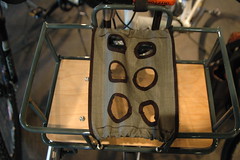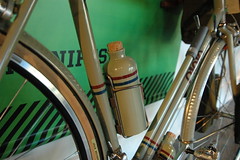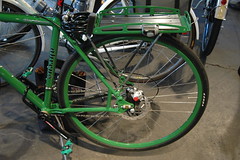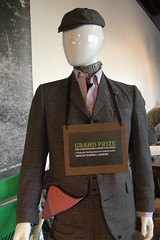
(Photo by Mark Reber for BikePortland)
[Welcome to our continuing coverage of the Oregon Manifest’s Constructor’s Design Challenge. See our previous coverage here.]
Report by Mark Reber, photos by Elly Blue

lightweight way to hold a six pack.
–Photo Gallery–
(Photos © Elly Blue/BikePortland
unless noted otherwise)
This morning’s coffee has worn off for the Constructor’s Design Challenge builders, but the enthusiasm and spirits are still running high. Their entries have been viewed by the judges and are now getting a critical eye by the public.
And, the public is getting an eyeful.
“You never know what’s going to come out, how someone will solve a problem or what inspiration you will get from others to solve your own.”
— Chris King, Cielo Cycles
As reported earlier, these 31 builders are favoring reliable, standard designs over the exotic. That makes sense. A transport bike needs reliability in both design and construction.
The gallery is full of bikes that, from a distance, may look standard: two triangles and a fork. But, take a closer look, and you will see innovations in racks and rack attachments, clever, but functional lighting systems, easy-to-reach brakes, integrated locks and alarms and fenders, fenders, fenders.
At the Constructor’s Design Challenge, it’s the details that make the difference. But, regardless of how any builder solves the challenge of keeping brake cables out of the way for the rider, all are showing bikes with attention to their aesthetic appeal, too.

Creek, Oregon, entered a mountain
bike with belt drive, racks, etc….
It’s no surprise that there are attractive and even beautiful bikes here. Many of these builders have their products showcased by riders and racers throughout the country. The bigger issue, and the one that can make a difference in the growing demand for a better transport bike, is how these designers arrived at their solutions and what that might mean for bicycle building everywhere. And, why a design challenge is important.
According to Chris King of Portland, Ore., whose Chris King Precision Components is the title sponsor of the event, the challenge provides inspiration and innovation.
“Stimulating creativity and innovation in design is one of the best results of this event,” he said. “It’s also fun,” he noted as he described how his own team of designers and builders solved problems. (The Cielo bicycle is not being judged in the event).
“An event like the Challenge is also about collaboration, both within our own teams, but also among other builders,” he said. “You never know what’s going to come out, how someone will solve a problem or what inspiration you will get from others to solve your own.”
Builders were happy to share the triumphs, and obstacles, of building for the Challenge and for the transport customer. We asked Mark DiNucci, DiNucci Cycles of Sisters, Ore, a veteran of the custom building business, what he thought might come out of this event.
“I wanted something that could be ridden every day to work or for shopping, then out to the race course. Pop the racks and fenders off and you have another bike, a cyclocross racer.”
— Mauricio Rebolledo, Rebolledo Cycles
“These guys need better access to frame components,” he said. “That would be very positive outcome.”
As a way of demonstrating the utility of a wide range of designs, he noted that, “A good town bike wouldn’t differ greatly from any good touring bike. That’s what many of the bikes here are based upon.”
Echoing the utility and flexibility angle was Mauricio Rebolledo, Rebolledo Cycles of Glen Ellen, Cal.
“I based my entry on a cross racing bike idea, but built it to be modular,” he explained. “I wanted something that could be ridden every day to work or for shopping, then out to the race course. Pop the racks and fenders off and you have another bike, a cyclocross racer.”
What attracts builders like Rebolledo to an event like this? Why spend the time and effort on a bike for an event when paying customers are standing in line?
“For me, it was the history of the technical trials, which this Challenge is based upon,” Rebolledo said. “They combined racing with transportation,” he said, obviously enthusiastic and eager to get to tomorrow’s starting line.
Jonathan Reed, Quixote Cycles of Portland, Ore. had a different view.
“I’m really drawn to utilitarian bikes, so I’m drawn to an event like this,” he said. “Ultimately, a bike is a functional tool.”
As he described his “functional” entry, we couldn’t help but noticed that it was the only bike in the Challenge with a custom-mounted, custom-built polo mallet.
“You never know when a pick-up polo match could break out,” he smiled and said.
According to Reed, one outcome from gathering so many custom builders together might be a movement to start a guild, where quality standards, not to mention lower group insurance rates, could be fostered. He had similar thoughts about standardization of components that would bring down building costs.
When asked about the bigger picture of how these bikes and their custom approaches to the basics like fenders or racks might influence bike trends, most builders thought it was the little things that will probably find their way to mass production. Most believed that seeing beautiful, well built bikes with fenders, dyno hubs, racks and saddle bags would spur bike manufacturers to offer those accessories as standard equipment. If a customer for a custom bike selling for more than $5,000, can be seen riding through town with fenders, racks and lights, it legitimizes the transport bicycle for others.
Besides the trends for commuting bikes, Steve Rex of Rex Cycles of Sacramento, Cal. thought that a real benefit of this Challenge was what it does for local craftsmen.
“This event promotes craftsmanship and local artisanship,” he said. “When folks patronize a local artisan, they are closer to the reality of how things get made. They get a greater appreciation for what it takes to build a functional and beautiful bike.”
Visitors to Oregon Manifest will gain that appreciation even if they have never set foot in a custom builders shop. Even better, they will get the satisfaction of seeing so many ways that the basic bicycle can be transformed into a beautiful, flexible and functional transport machine.
See more images in our photo gallery (all images by Elly Blue).








